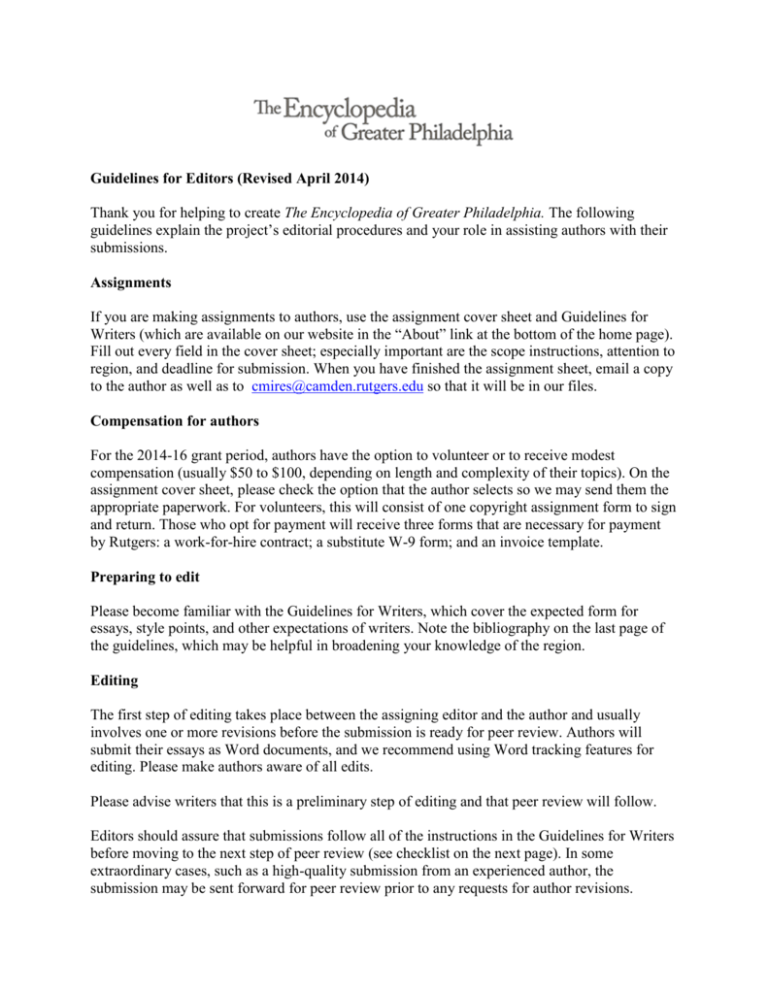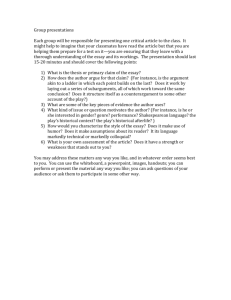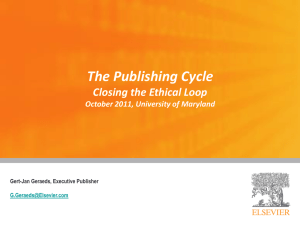Guidelines for Editors (revised April 2014)
advertisement

Guidelines for Editors (Revised April 2014) Thank you for helping to create The Encyclopedia of Greater Philadelphia. The following guidelines explain the project’s editorial procedures and your role in assisting authors with their submissions. Assignments If you are making assignments to authors, use the assignment cover sheet and Guidelines for Writers (which are available on our website in the “About” link at the bottom of the home page). Fill out every field in the cover sheet; especially important are the scope instructions, attention to region, and deadline for submission. When you have finished the assignment sheet, email a copy to the author as well as to cmires@camden.rutgers.edu so that it will be in our files. Compensation for authors For the 2014-16 grant period, authors have the option to volunteer or to receive modest compensation (usually $50 to $100, depending on length and complexity of their topics). On the assignment cover sheet, please check the option that the author selects so we may send them the appropriate paperwork. For volunteers, this will consist of one copyright assignment form to sign and return. Those who opt for payment will receive three forms that are necessary for payment by Rutgers: a work-for-hire contract; a substitute W-9 form; and an invoice template. Preparing to edit Please become familiar with the Guidelines for Writers, which cover the expected form for essays, style points, and other expectations of writers. Note the bibliography on the last page of the guidelines, which may be helpful in broadening your knowledge of the region. Editing The first step of editing takes place between the assigning editor and the author and usually involves one or more revisions before the submission is ready for peer review. Authors will submit their essays as Word documents, and we recommend using Word tracking features for editing. Please make authors aware of all edits. Please advise writers that this is a preliminary step of editing and that peer review will follow. Editors should assure that submissions follow all of the instructions in the Guidelines for Writers before moving to the next step of peer review (see checklist on the next page). In some extraordinary cases, such as a high-quality submission from an experienced author, the submission may be sent forward for peer review prior to any requests for author revisions. 2 Essay checklist Before submitting essays for peer review, editors are asked to assure that the submissions follow these guidelines (which are stated in the guidelines for writers): Form of essay: □ Summary introduction: In most cases, the first paragraph should define and explain the significance of the topic. The beginning of the essay will automatically appear in the Encyclopedia website’s table of contents, so it needs to be concise and substantive. □ Body of the essay: In most cases, a chronological narrative serves readers best. Conclude by returning to the significance of the topic. Some points of style: □ Avoid jargon or inflated language. □ Avoid quotations unless they are particularly distinctive or necessary; if they are necessary, keep them short. □ For each named individual, include lifespan dates in parentheses. □ Be as precise as possible with dates and locations. □ Avoid references to “now” or “today” so that the work does not become dated. □ The Encyclopedia does not publish footnotes. To acknowledge a scholar’s unique research, authors may include references in text (“as historian Randall Miller has discovered …”). Otherwise, simply include major works in the Related Reading list at the end of the essay. □ In general, we follow the Chicago Manual of Style. Required information at the end of the essay: □ Author biography: One or two sentences, including any major publications. □ Related reading: Up to 10 books and/or articles with full bibliographic citation (Chicago style). If the author needs to acknowledge additional primary source research, add a list of “Additional sources.” □ Places to Visit: Related historic sites, museums, historic markers, or other locations. In each case, include the street address. □ Collections: Related archival collections. Include the name(s) of specific collection(s), the name of the repository, and the street address of the repository. Optional information (include in the essay document, at the end): □ Suggestions for illustrations, if any. Do not send separate image attachments or paste images into the document. It is helpful to have links to digitized images, particularly in the collections of the Library Company of Philadelphia, the Historical Society of Pennsylvania, PhillyHistory.org, Visit Philadelphia, or the Library of Congress. If the author wishes to be involved with writing captions, indicate this as well. □ Suggestions for links to related websites, including virtual exhibits, digitized primary sources, audio, or video. □ The best location for pinning the topic to our master online map. (Only one location per topic is possible.) □ Any additional information that the author thinks will be useful to the editors, such as sources that are not included in the listings at the end of the essay. 3 Peer review The next step is to send the essay for peer review as a clean Word document (incorporating your edits, with no tracking visible). Before sending, make sure that all of the elements needed for publication, as listed on the previous page, are present. Everything should be in the Word document, which may be separated from your covering email when it is sent to reviewers. Associate editors should send this document to the editor-in-chief or one of the Encyclopedia’s co-editors for circulation to reviewers. Suggestions for reviewers are welcome; typically the reviews are done by one member of the Encyclopedia’s editorial board and/or one other expert in the subject of the essay. You may also be asked to review submissions edited by others. If this is the case, please respond promptly with your advice on whether the essay is ready for publication or if it needs further revision. We do not require a formal review but ask for your advice stated tactfully and in an organized manner so that it may be shared with the authors. Reviewers will remain anonymous unless they agree to allow their identities to be made known to the authors. Revisions following peer review When you receive reports from reviewers, assist the author in determining revisions that should be made and agree on a deadline for submitting the revision. (Do not reveal identities of reviewers unless they have agreed to be named.) It is now up to you to determine when the essay is acceptable, pending a final review by the editor-in-chief. Some extraordinary circumstances, such as difficulties in addressing a reviewer’s recommendation, may call for further consultation with the reviewers or other editors. In general, however, we do not repeat the peer review process at this stage of editing. Final submission When the submission is in its final, acceptable form, send it to the editor-in-chief or one of the co-editors. This submission should be a clean Word document, incorporating your edits without any visible tracking. All elements for publication should be in the document, not in the covering email, because the document will be detached for production. Please make sure the author has seen the final version of the submission. Production and publication You will be consulted if any questions arise during the publication process. Depending on staffing (which sometimes leads to combining some of these steps), the process includes: □ Acceptance by the editor-in-chief. □ Copy-editing. □ Fact-checking (which may be deferred to a later date, depending on staff). □ Acquisition of illustrations and preparation of captions. □ Construction of the web page. □ Proofreading and final review of the page by the author. Thank you for helping to create the Encyclopedia of Greater Philadelphia.






